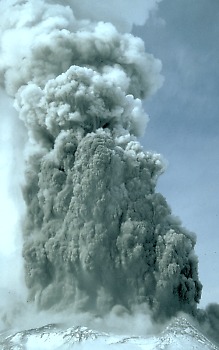phreatic eruption

Phreatic eruption at the summit of Mount St. Helens, Washington. Hundreds of these steam-driven explosive eruptions occurred as magma steadily rose into the cone and boiled groundwater. These phreatic eruptions preceded the volcano's plinian eruption on 18 May 1980. Credit: D. A. Swanson / US Geological Survey.
A phreatic eruption is a steam-driven explosion that occurs when water beneath the ground or on the surface is heated by magma, lava, hot rocks, or new volcanic deposits (for example, tephra and pyroclastic-flow deposits). The intense heat of such material (as high as 1,170°C for basaltic lava) may cause water to boil and flash to steam, thereby generating an explosion of steam, water, ash, blocks, and bombs.
A pseudocrater is a generally circular crater produced by a phreatic eruption.


